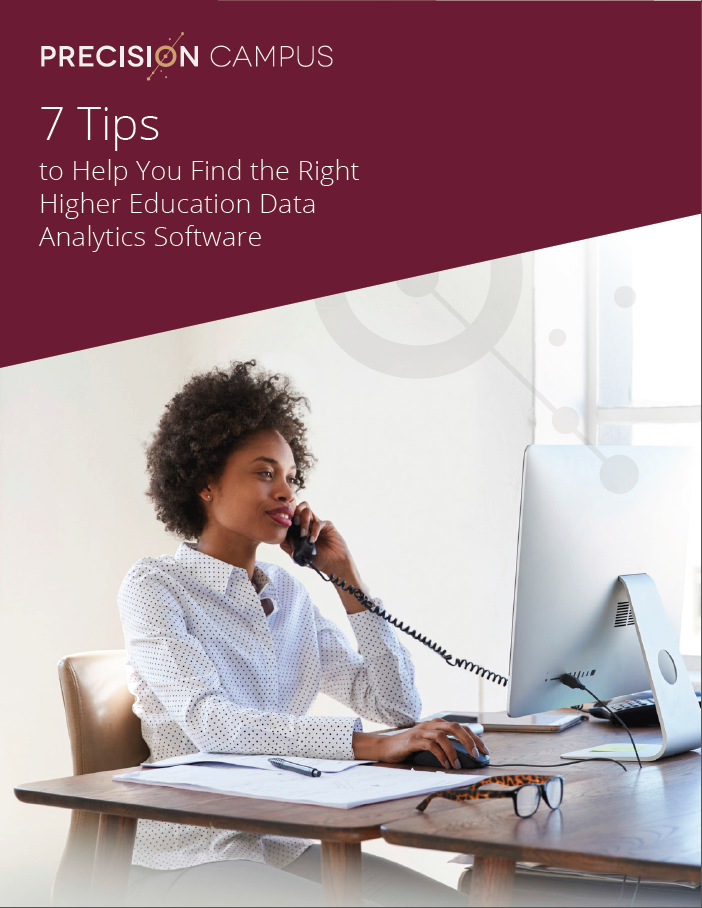Your institution’s most powerful tool is something you’ve already been collecting for years: Big data.
Big data refers to the massive amount of information that we create on a daily basis. Since students, teachers and administrators leave an endless trail of data throughout their time at your institution, this information can be used to gain insight into your performance — both at a high level (your entire institution) and a granular level (individual students).
How Educators Can Use Big Data
Data has been around long before computers, but technology has certainly accelerated the amount created every day. With the mobile devices, the internet of things (IoT), social media and other sources of information, we generate at least 2.5 quintillion bytes of data every day!
Clearly, this incredible volume of data is too complex for traditional tools to capture, store and manage. That’s where a data management program comes in. The right software will aggregate all of your necessary data sets and compile them in an easy-to-use, easy-to-understand dashboard. You can learn how to find the right data analytics platform for your school in this article.
Educators, decision makers and stakeholders are leveraging data analytics programs to identify institutional problems and spot opportunities for positive change.
Software programs enable analysis and interpretation that spans a diverse range of demographics, and from there you can develop new strategies to propel your institution forward.
Remember: The benefits of big data lie in how you use it — not how much you have. With that said, here are a few ways that the education industry can benefit from big data analytics.
1. It helps you find answers to hard questions
Evaluating your existing data is the best way to strategize solutions to the tough challenges facing the education field. The more you know about your history, the more you will be able to learn from it.
For example, if you’re in higher education you might be seeing enrollments decline. With big data, you have the context clues necessary to determine exactly where, when and how your enrollments are changing. Most notably, data can help you answer enrollment questions like:
- Are declines occurring in one department or across the entire institution?
- Is there a certain professor whose classes have low registrations?
- Can any sections be merged to increase productivity levels?
2. It’s accessible
Searching through a wall-to-wall arrangement of file cabinets is messy and time consuming. Since big data relies on a technological infrastructure to capture, store and manage information, it’s much easier to find what you’re looking for.
Beyond infrastructure, institutional silos can also make it difficult to share information. Leadership may be privy to data that teachers don’t have access to, which can create barriers to growth and understanding.
Data analytics, along with the right software, will help you create a more collaborative environment. Since data is available in one centralized location, all you need is internet access to find what you need. Many software tools are available through browsers, like Google Chrome and Safari, so you don’t even need to install a program or plug-in.
3. It can save costs
Proper resource allocation is crucial in higher education, and your data is the key to efficiency.
For one thing, your data can provide insight into the enrollment numbers of different class sections. If ENG 102 has five sections and only two are full, you can merge the remaining three to preserve resources like classroom space, teachers’ time and energy consumption.
Looking at this from an infrastructure perspective, cloud-based systems can potentially cut data storage costs and relieve pressure from your IT department. Data has traditionally required manual sorting and transcription, which is time consuming and can take weeks if not months. And if you need customized reports compiled on a regular basis, this can take just as long.
Your employees’ time can likely be spent doing more beneficial tasks. An analytics program will automate a lot of this tedious work and the luxury of digital information makes accessing data quick and easy, which can save you money in the long run.
Another cost-saving benefit is for higher education recruitment efforts. By looking at past school performance, your data can show you which prospective students will be likely to succeed at your institution as well as who may be more likely to drop out or fail. This can help you create more successful acceptance processes that maximize the ROI on each student.
4. It’s quick
We mentioned this briefly under the cost-saving benefit, but it bears repeating. With all of your school’s information available in one centralized location, you’ll save an incredible amount of time weeding through data just to find one specific report or information about a particular student.
Big data is also available in real time, so you can make decisions quicker than ever before. This is particularly helpful during enrollment periods, when educators are tracking numbers in order to prepare for the upcoming semester. Your Year-Over-Year Enrollment reports can be automated to help you gauge how enrollments are faring compared to the same time in the previous year. Then, you can make same-day decisions to improve or continue the steadiness of your enrollments.
5. It helps you adapt
By identifying trends, you can develop new classes, teaching strategies and other methods to give students what they need and want.
Take community colleges as an example. These schools are mostly populated by adults who are balancing work, families and their education, so a flexible schedule is one of their requirements when looking for a school. With the expansion of online learning, many of these adult students find online classes to be even more convenient than late night or weekend classes.
Since online learning is better suited for certain types of classes — like ones that don’t require a lab or hands-on learning — big data will show the precise numbers behind this. Maybe on-campus biology class enrollments have been consistent while on-campus English courses have seen a decline. You can adjust your course offerings accordingly to ensure you’re always offering the best options for your students.
Precision Campus makes storing and managing your institutional data quick and easy. With interactive dashboards and visual interpretations of your data, you can gain the context you need to better understand your institutional performance.
Want to get started for free? Sign up for the free version of Precision Campus today!



